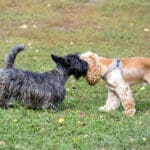Does your dog become anxious in certain situations? Does she bark excessively when people come to the house or act destructively when you leave her alone? If so, in many cases, you can take steps to reduce her anxiety. The first step is understanding how your dog perceives her environment and what triggers can cause stress. Here we will offer some valuable tips on how to relax and calm anxious dogs. Keep reading for more.
Establish a routine
Dogs thrive on consistency and predictability, so create a regular schedule for feeding, potty breaks, and playtime. This will not only help your dog better adjust to her surroundings, but also help you efficiently manage your time and responsibilities.
Provide exercise
Regular physical activity helps to reduce anxiety in dogs by providing an outlet for pent-up energy and stress. Most dogs enjoy going on walks and runs. Many also like playing fetch. When exercising your dog, make sure it is in a safe area. Either walk your dog on a leash or exercise her in a securely fenced area. If your dog is uncomfortable around other dogs, then going to a dog park or area with other dogs can cause more anxiety.
Practice desensitization
When dogs are fearful, they become anxious. It’s common for dogs to be fearful of new environments and people. Rather than overwhelming or flooding your dog with new stimuli, gradually introduce her to new environments, people, or objects in controlled settings. By doing this, you can help them become more comfortable and confident when faced with unfamiliar situations. For example, if you want your dog to be comfortable going to a pet supply store, choose a time when the store is not very busy for your first visit. You might have to take multiple trips during non-busy times before your dog is comfortable with this. Once she is comfortable with this, try when it’s a bit busier. If your dog is calm and enjoying this, you can continue increasing the stimuli (or store busyness).
Keep a positive attitude
Building trust between you and your dog can have calming effects. Positive reinforcement and rewarding your dog with treats or verbal praise when showing relaxed behavior is an excellent way to build trust. Instead of scolding a dog for an unwanted behavior, teach her to perform the behavior you want. For example, most people don’t want a dog to jump up on a person as a greeting. Instead of punishing the jumping behavior, consider the behavior you want when meeting a new person. Most people want the dog to sit. So, teach the dog to sit. Then, when a person approaches, tell the dog to sit and give her a treat. Both you and the dog will be happier with the results.
Give them something to do
When pets are left alone, boredom can cause distress. Give your dog something to keep her busy. This could include puzzle toys, Kong toys, and chews.
Consider herbal remedies or medications
If the above tips are not working, consult your veterinarian about herbal remedies or medications that may help calm anxious dogs. Information about what triggers your dog’s anxiety can help your vet determine the best course of action.
Taking proactive steps to address your dog’s anxiety is essential for maintaining a happy and healthy pet. Creating consistent routines, providing regular physical exercise, and desensitizing your pup to new environments are some of the many effective strategies to help reduce stress in anxious dogs. Additionally, offering puzzle toys or interactive activities can keep an anxious pup entertained while home alone.
If these steps don’t seem to be helping alleviate your pup’s anxiety, consult your veterinarian. Your veterinarian will be able to determine if an underlying physical issue might be the problem. Also, your veterinarian can help you decide if herbal remedies or other medications might be an option.
Because anxiety doesn’t usually just go away, it’s best to be proactive—and if you need help, please call us and schedule an appointment.






